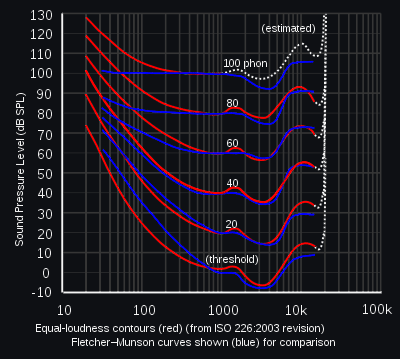When I first started mixing, I had a strong tendency to continuously increase the volume I was mixing at, either by increasing the level of my master fader (which should always, always remain at 0 dB!) or by raising my monitor volume. There are two fundamental principles that cause this tendency:
The first is ear fatigue. Ear fatigue occurs when you listen to music for too long and your ear, trying to protect itself from continuous bombardment, starts to shut down and block out the sound. The best way to prevent this from happening and from interfering with your mixing is to take regular breaks during a session (probably at least 15 mins every 2 hours).
The second principle has to do with the way we perceive different frequencies at different loudness levels and, together with ear fatigue and increased volume, is often the reason we end up with an unsatisfying mix that is lacking lows and highs.
In 1933, Fletcher and Munson performed an audio experiment where listeners were asked to (subjectively) compare the perceived loudness of two different tones – one reference tone at 1 kHz and a second tone of a random test frequency. Fletcher and Munson then graphed their findings into a number of curves known as the Fletcher-Munson Curves. This experiment was re-examined later with similar findings which became the basis for the ISO 226 standard.

The way to read this graph is as follows: look at the blue curve at the 1 kHz / 40 dB point. Now follow the curve towards the left until you reach 50 Hz on the horizontal axis. You should now read about 70 dB on the vertical axis. In essence, this states that in order for a 50 Hz tone to be perceived as loud as a 1 kHz tone is at 40 dB, it needs to be played at 70 dB. That’s 30 dB difference! A similar thing happens when you move into the high frequencies. A 10 kHz tone needs to be played at about 55 dB to be perceived at the same loudness level. Notice that this difference in loudness evens out as the volume increases (the curves higher up in the figure), for example at 100 dB, the curves have flatten out considerably, meaning the perceived loudness difference between tones at different frequencies decreases.
There are two important things to take away from these curves:
- We are less sensitive to low and high frequencies, we hear mid frequencies more prominently (especially between 1-5 kHz)
- As the volume increases, this perceived loudness difference between the frequencies diminishes
In terms of mixing, this principle is the main reason why we have a tendency to increase the volume; as we raise the levels, the low and high frequencies become more prominent in the overall mix, leading to increasing power (lows) and clarity (highs). This makes the music appear more appealing to our ears and thus we often feel that ‘louder is better’. However, if we mix at very loud levels and then play the mix back at a lower volume, we will often find that we end up with a weak and muddy mix containing mainly mid frequencies.
There is no ‘simple fix’ for this problem. Your approach will also depends on your target audience and on how loud they are likely to play your music. Personally, I like to listen to my mix at different volume levels, from very soft to pretty loud, just to get a feeling for how well my overall frequency distribution will hold up in different situations and to make the mix as loudness proof as possible.
It is very useful to be aware of ear fatigue and our perception of frequencies at different levels and I hope it will be beneficial to your mixing!




7 Responses
Ear fatigue is NOT taught anywhere NEAR enough in any audio classes I’ve read or been in. Also the natural compression your ears provide as safety features are rarely ever discussed. I myself feel the above statement of a 15 minute rest after 2hrs of mixing is nowhere near enough. A critical mix should only be done after a full nights rest and the first thing you mix in the next day. Just listen to how loud your TV is in the morning after the night before. Quite a difference even with a TV at home, let alone a criticle mixdown. REST YOUR EARS! REST YOUR EARS!
Try this…
Play some pink noise at wherever your 0 VU is calibrated to (usually -12db for music and -18db for broadcast). Use an SPL meter, and raise your monitoring volume until the SPL is at 87db and mark that spot as the best place to listen.
87db is where the fletcher-munson curve is the most “flat.” Mixing at this volume will give you the most consistent results across all volumes. YMMV.
Don’t forget to put up some reference mixes to get your ears used to listening. I find 80’s music are the best reference mixes because it’s not as compressed. But, have a range of material.
“However, if we mix at very loud levels and then play the mix back at a lower volume, we will often find that we end up with a weak and muddy mix containing mainly mid frequencies.”
This is certainly not my experience. Actually it is the other way around. If I mix at low level I have too much bass leading to dull muffled mixes. If I mix at 83dBs then I hear much more bass energy and so turn it down leading to clearer mixes with a better spectral balance. I consider 83dBs very loud so I am only there for enough time to make critical mix changes.
I guess everyone mixes differently :) I haven’t actually done any mixing in many years now, but appreciate you taking the time to share your experience!